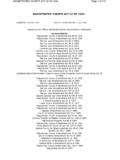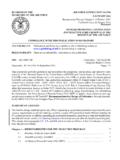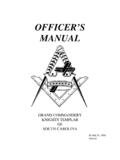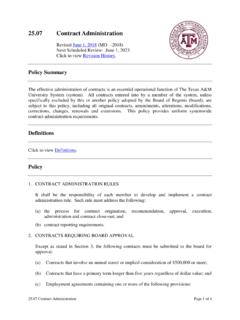Transcription of Noncommissioned Officer Development Program
1 Army Regulation 350 17. Training Noncommissioned Officer Development Program Headquarters Department of the Army Washington, DC. 31 May 1991. UNCLASSIFIED. SUMMARY of CHANGE. AR 350 17. Noncommissioned Officer Development Program This revision-- o Improves command emphasis and understanding of the Noncommissioned Officer Development Program (NCODP) in units and brings the Program on line with current leader Development and unit training doctrine throughout. o Includes responsibilities of the NCODP (para 4). o Reflects policies of the NCODP (para 5). o Updates goals and objectives for the NCODP (para 6). o Provides suggested procedures for unit level implementation of the NCODP. (para 7). Headquarters *Army Regulation 350 17. Department of the Army Washington, DC.
2 31 May 1991 Effective 28 June 1991. Training Noncommissioned Officer Development Program Noncommissioned Officer Development pro- regulation are not official unless they are au- gram into the Army's leader Development thenticated by the Administrative Assistant to Program . the Secretary of the Army. Users will destroy Applicability. This regulation applies to the interim changes on their expiration dates un- Active Army, the Army National Guard, and less sooner superseded or rescinded. the Army Reserve. This regulation is applicable during mobilization. Suggested Improvements. The propo- Proponent and exception authority. nent agency of this regulation is the Office of Not applicable. the Deputy Chief of Staff for Operations and Army management control process.
3 Plans. Users are invited to send comments This regulation is subject to the requirements and suggested improvements on DA Form of AR 11 2. It contains internal control pro- 2028 (Recommended Changes to Publica- visions but does not contain checklists for tions and Blank Forms) directly to HQDA. conducting internal control reviews. These (DAMO TRO), WASH DC 20310 0450. checklists are being developed and will be published at a later date. History. This UPDATE printing publishes a Distribution. Distribution of this publica- Supplementation. Supplementation of this revision of this publication. This publication tion is made in accordance with the require- regulation and establishment of command has been reorganized to make it compatible and local forms are prohibited without prior ments on DA Form 12 09 E block number with the Army electronic publishing database.
4 Approval from HQDA (DAMO TRO), 2164, intended for command levels A, B, C, No content has been changed. WASH DC 20310 0450. D, and E for Active Army, Army National Summary. This regulation provides doctrine Interim changes. Interim changes to this Guard, and Army Reserve. and guidelines for the synchronization of the Contents (Listed by paragraph and page number). Purpose 1, page 1. References 2, page 1. Explanation of abbreviations and terms 3, page 1. Responsibilities 4, page 1. Policy 5, page 1. Goal and objectives 6, page 1. Suggested procedures 7, page 1. Appendix A. References, page 3. Glossary Index *This regulation supersedes AR 350 17, 15 December 1986. AR 350 17 31 May 1991 i UNCLASSIFIED. RESERVED. ii AR 350 17 31 May 1991. 1. Purpose (2) Implement the commander's directives and guidance on the This regulation establishes policy for the Development and imple- unit's NCODP.
5 Mentation of the Noncommissioned Officer Development Program (3) Be responsible for content, pertinence, and implementation of (NCODP) in battalions, separate companies, and equivalent the unit's NCODP. organizations. (4) Assess the NCODP utilizing the Program goal and objectives stated in this regulation. 2. References (5) Provide feedback to the unit commander concerning the Required and related publications and referenced forms are listed in NCODP effectiveness as part of the training evaluation process (FM. appendix A. 25 l01, app F). 3. Explanation of abbreviations and terms 5. Policy Abbreviations and terms used in this regulation are listed in the a. The NCODP is a hands-on Program , tailored to the unique glossary. requirements of the unit.
6 B. As with all leader training, the NCODP is a command respon- 4. Responsibilities sibility. The Program reflects command priorities and expectations a. The Deputy Chief of Staff for Operations and Plans for leader Development , jointly determined by commanders and their (DCSOPS) will senior NCOs. (1) Provide Department of the Army level policy for the c. The NCODP is a battalion, separate company, or equivalent NCODP. level Program . It is equally applicable to both table of organization (2) Coordinate initiatives related to the NCODP with the Ser- and equipment units and table of distribution and allowances units. geant Major of the Army (SMA). d. The NCODP consists of training programs , formal and infor- b. The Deputy Chief of Staff for Personnel (DCSPER) will coor- mal, one-on-one or groups, involving coaching as well as instruc- dinate all personnel management, quality of life, and educational tion, and will be fully integrated into the daily routine of the unit.
7 Initiatives that may be related to the NCODP, with ODCSOPS and e. The NCODP builds upon the contributions of the Army's En- the SMA. listed Personnel Management System and the sequential and pro- c. The SMA will gressive design of the Noncommissioned Officer Education System. (1) Advise the DCSOPS on all matters related to NCODP. These two systems provide a valuable foundation for the develop- (2) Render an annual report to the Chief of Staff, Army, on the ment of NCOs; however, it is through the application of SKAs in state of the Army's Noncommissioned Officer Corps. This includes the unit that soldiers become quality NCOs. an assessment of the implementation of NCODP in major Army 6. Goal and objectives commands (MACOMs), the Army National Guard (ARNG), and the a.
8 The goal of the NCODP is to increase and sustain NCO. Army Reserve (USAR). combat readiness at the highest possible level. d. The Chief, National Guard Bureau, will b. Objectives of the NCODP are to . (1) Integrate the NCODP into pertinent ARNG directives and (1) Develop and strengthen leadership skills and professional at- programs . tributes within the NCO Corps. (2) Provide advice and assistance to the DCSOPS. (2) Provide guidance in the continuing Development of NCOs by e. The Chief, Army Reserve, will taking advantage of opportunities to send leaders to appropriate and (1) Integrate the NCODP into pertinent USAR directives and affordable technical, developmental, skill qualification, and confi- programs . dence building courses. (2) Provide advice and assistance to the DCSOPS and direction (3) Increase confidence of the NCO through identification for to the Commanding General, Army Reserve Personnel Center, and assignments to positions of greater responsibility as the NCO.
9 In the Development of the NCODP supporting programs for the develops and demonstrates increased leadership ability. USAR. (4) Realize the full potential of the NCO support channel. f. MACOMs will (5) Increase unit effectiveness and combat readiness through im- (1) Provide necessary support to promote effective NCODPs in proving NCO quality, morale, performance, and potential. all units and activities. (6) Foster a unit environment that enhances continued NCO. (2) In addition to the above, the Commander in Chief, Forces leader Development . Command, will provide NCODP guidance and assistance to the ARNG and USAR. 7. Suggested procedures In order to accomplish battle-focused NCO Development , command- g. Commanders of battalions, separate companies, and equivalent ers and unit NCOs should follow the procedures below.
10 Organizations will . a. Link NCO Development to the current skill level and duty (1) Be responsible to develop and implement an effective assignments so that the NCODP is . NCODP. (1) Sequential and progressive. (2) Ensure the Program supports the unit mission and enhances (2) Battle focused. Development of Noncommissioned officers (NCOs). (3) In accordance with existing and emerging doctrine. (3) Ensure that the Program has stated objectives with measura- b. Establish a viable unit level NCODP using unit METL as the ble and reachable standards. vehicle to incorporate the following into each NCO's daily (4) Ensure time and other resources are provided for the conduct activities. of the NCODP. (1) The SKAs in accordance with current rank (TC 22 6).









